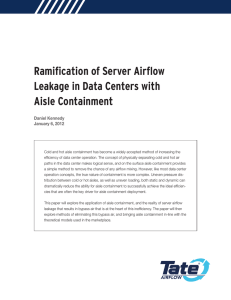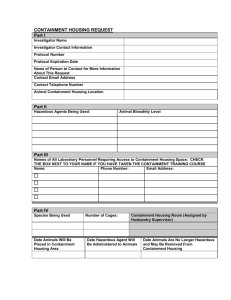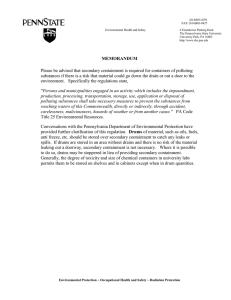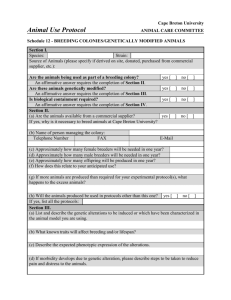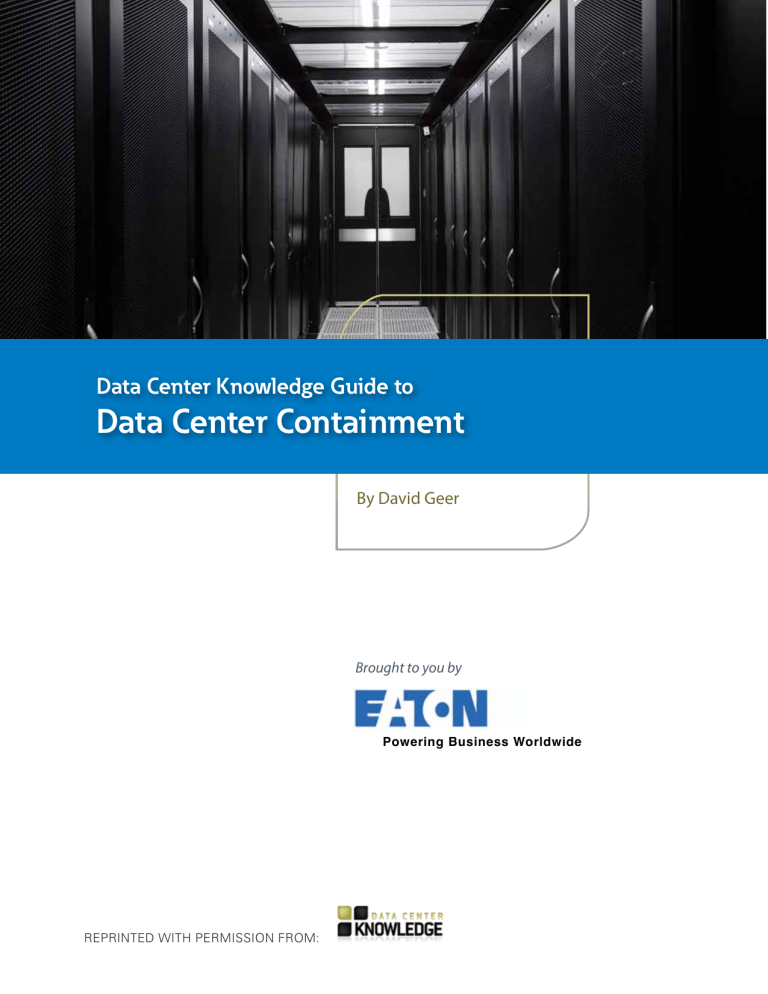
Data Center Knowledge Guide to
Data Center Containment
By David Geer
Brought to you by
Powering Business Worldwide
REPRINTED WITH PERMISSION FROM:
Data Center Knowledge Guide to Containment
Executive Summary
Economics and growing demand for compute cycles,
web-based applications and content are driving data
centers to find new ways to keep power consumption
in check. While doing so, enterprise data centers continue to struggle to add highly dense computing capacity in the same space. Data center airflow management
cuts energy costs while enabling affordable, scalable,
modular growth of compute pods in the facility. Rack or
row-based containment is the best long-term approach
to address a majority of these concerns.
Contents
A data center that examines the available containment
approaches and aligns these with its infrastructure
needs will secure the greatest efficiencies and the
most benefit for IT and the business.
Containment Benefits. . . . . . . 6
With most large data centers effectively employing
some form of containment to address growing costs for
electricity and a static amount of power supply, containment has taken strong root in the data center floor plan.
Containment Providers and
Due Diligence . . . . . . . . . . . . . 9
Executive Summary. . . . . . . . . 2
What is Data Center
Containment? . . . . . . . . . . . . . 3
Containment Approaches . . . . 5
The History of Data Center
Containment . . . . . . . . . . . . . . 5
Why Containment? . . . . . . . . . 6
Why Now?. . . . . . . . . . . . . . . . 7
Containment Components . . . 7
Containment Considerations. . 8
Matching Containment to
Considerations. . . . . . . . . . . . . 9
Prove Containment with
Leakage Testing. . . . . . . . . . . 10
Recommendations . . . . . . . . 10
Summary. . . . . . . . . . . . . . . . 10
References . . . . . . . . . . . . . . 10
2
Data Center Knowledge Guide to Containment
What is Data Center Containment?
Though the two are related, data center containment has a different focus than data center
cooling. While cooling uses resources such as
CRAC/CRAH units to cool equipment in data
center racks and rows, containment increases
the efficiency of cooling approaches.
Data center containment applies barriers,
components and methods to contain and direct
air flow to keep hot and cold air from mixing in
the environment. Air mixing dilutes the cooling
process by warming cool air intended to cool
the equipment and cooling hot air before it hits
cooling equipment coils, reducing energy efficiency of the CRAC/CRAH units.
Containment directs hot air to air conditioning
return ducts and cold air to equipment rack
fronts (see Figure One). Separating hot and
cold air enables cooling equipment to efficiently
bring the hottest air down to a predetermined,
appropriate temperature, lowering energy bills
and eliminating the need for additional cooling
equipment. The industry refers to this substantial difference between the supply and return
air temperatures as the Delta T (∆T).
Airflow Resulting from Containment
(Figure One)
Temperature (F)
– 95
– 87
– 79
– 71
– 63
– 55
3
Data Center Knowledge Guide to Containment
Understanding the Delta T
door (bottom/middle/top) of IT racks. SubtractWhat is the Delta T? Delta T = Final Temperaing T2 from T1 will usually result in a Delta T of
ture minus Initial Temperature. The data center
can measure Delta T for individual rackmounted 10-20F, which identifies the supply path losses.
Reduction of this supply path Delta T will
IT devices, which vendors design to operate
increase cooling performance in the data center
within defined inlet temperature ranges. The
allowing higher rack densities.
manufacturer typically pre-determines the
temperature rise or Delta
T, which can range from
Four Temperatures of Data Center Airflow Measurement
20-40F. Although most
(Figure Two)
server manufacturers
specify their operating
temperature range at
50-95F, ASHRAE TC9.9
recommends maintaining
device inlet temperatures
between 64.40-80.60F.
Significant gradient of
air temperatures beyond
ASHRAE TC9.9 places
devices at risk of thermal
shutdown.
The data center can also
measure Delta T for an
individual IT rack or row
of IT racks from the cold
aisle front side of the
rack(s) to the hot aisle
rear side of the rack(s). However, measuring
Delta T at the room level in a typical data center
provides the most critical information for data
center managers to provide a reliable environment for their IT devices while maximizing
energy efficiencies.
To understand the thermal environment in a
typical data center with open-air distribution
(no containment), measure “the four temperatures” (see Figure Two). On the supply side,
T2 is the average temperature of the cold air
measured immediately as it exits the CRAH/
CRAC units and T1 is the average temperature
of the air measured at the front
On the return side, T3 is the average temperature of the hot air measured at the rear
door (bottom/middle/top) of IT racks and T4 is
the average temperature of the air measured
just before it enters the CRAH/CRAC units.
Subtracting T4 from T3 on the return side will
usually result in a Delta T of 10-20F, which identifies the return path losses. Reduction of this
return path Delta T will increase cooling energy
efficiency and could save data center managers
up to 30-percent on their annual utility bill.
4
Data Center Knowledge Guide to Containment
Containment Approaches
Legacy data centers employ a hot aisle/cold
aisle arrangement of the IT racks. The fronts of
the racks face each other and draw cold air into
the rack to cool rack mounted IT devices (i.e.
servers, switches, etc.). Conversely, the rear
sides of the rows of racks face one another, expelling the hot air into the hot aisle. The issue
with hot aisle/cold aisle designs is that the air is
free to move wherever it will.
In a cold aisle containment approach, the data
center installs end of row doors, aisle ceilings
or overhead vertical wall systems to contain
the conditioned air that cooling systems send
into the cold aisles and ensure that only that air
flows into the air intakes of the rack-mounted
IT devices. The data center contains the cold
aisle to keep the cold air in and the hot air out.
In hot aisle containment, the hot aisle is contained so that the precision air conditioning
units only receive hot air from the aisles. Again,
the data center contains the hot aisle to keep
the hot air in that aisle and the cold air out (see
Figure Three).
Data Center with Hot Aisle Containment
(Figure Three)
The History of Data Center
Containment
During the mid- to late- 1980s, David Martinez
of the Sandia National Laboratory attached fire
code compliant welding curtains between the
top of the CRAC units and the ceiling to form
an airflow plenum to
protect the first TeraFlop high-performance
What are ASHRAE and
computing machine.
the IEEE?
“The goal was to
ASHRAE (the American
utilize the interstitial
Society of Heating,
space between the
CRAC unit top and the
Refrigerating and Air
ceiling to draw the reConditioning Engineers)
turn air back to the top
is the century old
of the CRAC units,”
member organization
says Martinez.
focused on building
This helped to ensure
HVAC systems, energy
sufficient airflow and
efficiency, and indoor air.
to correct a short cycling issue. “It enabled
The IEEE (the Institute of
us to make better use
Electrical and Electronics
of our CRAC units’ ∆T,
Engineers) is the global,
which in turn resulted
professional member
in our chiller plants runorganization committed
ning more efficiently,”
to advancing technology
says Martinez. Martinez eventually found
in service of humanity.
cold aisle containment
to be effective as well.
In the early 1990s,
vendors began developing and marketing various containment systems.
The data center community has opted for
guidelines rather than standards to address
both cooling and containment best practices
because data center cooling components vary
so much. The ASHRAE “Thermal Guidelines for
Data Processing Environments” and several papers on data center containment systems from
the IEEE are among those guidelines.
Today, containment solutions must meet fire
codes and general human life safety requirements as well as provide access, from the top
of the racks to the bottom, for maintenance
activities.
5
Data Center Knowledge Guide to Containment
Why Containment?
The data center is fraught with power and cooling
challenges. For every 50 kW of power the data
center feeds to an aisle, the same facilities typically
apply 100-150 kW of cooling to maintain desirable equipment inlet temperatures. Most legacy
data centers waste more than 60% of that cooling
energy in the form of bypass air.
Data centers need more effective airflow management solutions as equipment power densities increase in the racks. Five years ago the average rack
power density was one to two kW per rack. Today,
the average power density is four to eight kW per
rack and some data centers that run high density
applications are averaging 10 to 20 kW per rack.
The cost of electricity is rising in line with increasing
densities. “The cost of electricity is about US$0.12/
kWh for large users. The forecast is for a greater
than 15-percent rise in cost per year over the next
five years,” says Ian Bitterlin, Chief Technology
Officer, ARK Continuity.
Containment Benefits
Vendors design containment solutions for fast, easy
deployment and scalability for data center growth.
Data center containment enables the creation of a
high-capacity data center in
a very short period of time
(hours).
What is PUE?
PUE (Power Usage
Containment enables IT
Effectiveness) is a
professionals to build out
formula for deterinfrastructure, data processmining data center
ing, and cooling loads in
energy efficiency
small, controlled building
such that Total
blocks as demand grows.
Power to Data CenThis is more affordable than
ter divided by Power
building the data center
to Run Computer
infrastructure to handle the
Infrastructure = PUE.
maximum cooling and data
processing load from day
one, which is the traditional
method. Containment increases its cost effectiveness as rack densities increase.
Containment makes existing cooling and power
infrastructure more effective. Using containment,
the data center makes increasingly efficient use
of the same or less cooling, reducing the cooling
portion of the total energy bill. Data centers can
even power down some CRAC units, saving utility
and maintenance costs. Containment allows for
lower cooling unit fan speeds, higher chilled water
temperatures, decommissioning of redundant
cooling units and increased use of free cooling. A
robust containment solution can reduce fan energy
consumption by up to 25-percent and deliver
20-percent energy savings at the cold water chiller,
according to the U.S. EPA.
Data centers typically have more cooling capacity
than the load requires. Still, this capacity does not
cool equipment adequately. By raising the Delta T,
containment avoids the capital expense of adding
more mechanical cooling. As you operate cooling
under higher return temperatures, cooling becomes
more efficient.
Containment makes running racks at high densities
more affordable so that data centers can add new
IT equipment such as blade servers. Data
center containment brings the power consumption
to cooling ratio down to a nearly 1 to 1 match in kW
consumed. It can save a data center approximately
30-percent of its annual utility bill (lower OpEx)
without additional CapEx
Standardization is an operational benefit of containment. Vendors engineer containment into building
blocks so that as the data center grows, the enterprise simply adds more uniform pods. Containment
reliability and integrity derive from design redundancy that mitigates the downside risk of cooling
system failures.
The smaller the percentage of total energy the
data center uses to feed cooling, the greater the
percentage of total energy it uses to feed IT equipment. This results in a lower PUE, which should be
closer to a 1:1 ratio.
Containment aligns with the enterprise by offering a
low TCO including low and progressive acquisition
costs, quick time to deploy, and lower operational
and maintenance costs. Maintenance costs grow
only as the data center adds containment pods.
6
Data Center Knowledge Guide to Containment
Why Now?
Airflow management using rack and row-based
containment is growing in popularity. “According to our most recent survey, 78-percent
of large data center operators have deployed
airflow containment,” says Matt Stansberry,
Director of Content, Uptime Institute.
According to the U.S. EPA, improving the energy efficiency of America’s data centers by only
10-percent would save more than 6 billion kWh
per year, enough to power more than 350,000
homes and save more than $450,000,000 annually.
In a number of locales around the U.S., utility
companies are offering data centers rebates to
use for capital investment in containment solutions to drive higher efficiencies, save energy,
and lower utility bills. Some rebates are sufficient to fund much of the expense of new
containment solutions.
Containment Components
Containment components include rack containment using rack-based chimneys, and aisle
containment using end of row doors, aisle ceilings and overhead vertical wall systems. Chimneys affix to the hot air side of the rack, ducting
hot air into a drop ceiling or return plenum that
leads to the air conditioning system. Passive
chimneys use the plenum’s negative pressure
to pull the hot air out. Active chimneys with
fans move hot air based on rack temperature
or the difference in pressure inside and outside
the rack.
Door configurations include swinging or sliding
doors that are available as single or double
doors. The data center may require an emergency break out feature for sliding doors to
meet emergency evacuation safety standards.
When a smoke or fire alarm sounds, staff
members can break through the door via a
break out bar that opens a separate door on
a hinge. This will ensure that staff are not
trapped in an emergency.
Vendors offer additional door options including
auto-close, soft close and auto lockout capabilities. Auto-close enables the door to quickly
reestablish an airtight seal. Soft closing doors
use snubbers to slow auto-closing. This ensures that the doors won’t close on the staff
or customers who are entering or leaving the
aisle. Auto lockout stabilizes doors in the open
position allowing hands to be free to move data
center equipment in and out of the aisle.
Glass doors or small windows are available
for data centers seeking visibility into the aisle.
Glass doors and windows maintain aisle visibility without forcing staff to enter the aisle.
Data centers can top off their aisles with
precise ceiling types and options as the vendor
brings them closer to total containment. The
vendor can deliver a horizontal structure, which
is a flat-aisle covering or roof. The overhead
vertical wall approach constructs one wall along
the top of a row of racks, a second vertical wall
on the top of the opposing row of racks and
one at each end of the aisle, creating a rectangular box that contains the air.
End of row doors seal off the end of the aisle.
Vendors offer end of row doors in a variety of
practical configurations. The vendor should be
able to tailor door selections to suit each data
center’s specific spatial requirements.
7
Data Center Knowledge Guide to Containment
Containment Considerations
There are a number of factors that data centers
should consider when selecting containment
solutions. The application specific environmental requirements of the data center including
the cooling supply source and type, fire suppression design, the human factor and rack
hygiene form one set of factors.
climate to an environment that is either too hot
or too cold while also considering the effect of
moving between the two when working inside
and outside the aisle.
Air Leakage Through the Rack
(Figure Five)
The data center should marry cooling that emanates from CRAC units, raised floors, perimeter cooling, and overhead cooling systems to
the most compatible containment option. For
example, while the hot aisle approach is usually
best for CRAC/CRAH units, the cold aisle approach is usually best for perimeter cooling on
raised floor or ducted cold air delivery from roof
top chillers.
Data center fire suppression techniques including sprinklers, gas systems and VESDA systems can affect containment selection. Vertical
walls (see Figure Four) and horizontal structures with intelligent panels are best suited for
overhead fire suppression.
Vertical Wall
(Figure Four)
Data center employees and customers may
not want to work in a data center environment
that is 100-degrees. If the data center contains
the cold aisle, the rest of the data center is the
hot aisle, which can be 95- to 110- degrees. If
the data center contains the hot aisle, the rest
of the data center will be cold. When staff or
customers enter the hot aisle, it will be 95- to
110-degrees. The data center may want to factor in the effect of requiring its personnel to ac-
Once containment is in place, the rack becomes an airflow plenum. The data center that
invests in containment should not waste the
effort by permitting poor rack hygiene and air
leakage through the rack (see Figure Five). In
an aisle with 10 racks on each side or 20 in the
pod, the racks make up approximately 60-percent of the total surface area. Leaking racks
could lead hot and cold air to mix, defeating the
data center’s containment efforts.
The data center should plug leaks both around
the 19-inch rails in front of the racks and in
any empty U spaces among the rack mounted
equipment by using blanking panels. Plug
holes in raised floors around cabling with
floor grommets.
8
Data Center Knowledge Guide to Containment
Containment Providers and
Due Diligence
When considering containment providers
and their solutions, make sure to do your due
diligence. Consider the following points during
that process.
• Know your heat containment needs and
how much heat you need to manage.
• Know the thermal profile of all equipment
coming into the data center.
• Know the fire protection codes and how
containment will affect these.
• Know what else the containment strategy
will affect.
• Know how much cooling you need up front
and how much to plan for the future.
• Know what you are supporting today for IT
and the business and how business decisions will affect future planning.
• Link facilities planning to business planning.
• Know room geometry and the constraints
of cold air delivery and hot air removal
when planning for containment.
• Know your space and how well a vendor
solution will integrate with the existing
racks, whether uniform or non-uniform
• Know whether you will have an outage
window for installing containment and the
risks around production equipment during
containment assembly.
Matching Containment to
Considerations
Each containment method has its own
benefits and concerns. Hot aisle containment contains only the heat, channeling
it away and leaving the rest of the data
center as the cold aisle. Depending on how
cold the cold aisle is, this may leave the data
center with an expensive, frigid data center
that is as costly as it is uncomfortable. With
current ASHRAE standards recommending
that data center equipment run at higher
temperatures, the cold aisle may not necessarily have to be so cold that it incur costs or
cause comfort concerns.
Hot aisle containment works well with
CRAC/CRAH units because the data center
manager can easily set these to cool the rest
of the data center, regardless of the cooling
units’ relative location. However, hot aisle
containment only works when the data center uses containment on all hot air exhaust
paths.
Cold aisle containment is good for perimeter
cooling because CRAC/CRAH units at the
perimeter can supply the cold air through a
raised floor. Cold aisle containment does not
require the data center to use containment
everywhere, but the data center must channel hot air back to CRAC units to maximize
the efficiency of this method. End of row
doors are friendly to hot and cold aisle containment, raised floors and drop ceilings.
The data center should match ceiling approaches to important considerations such
as overhead fire suppression, cable ladders,
cable trays and piping. Methods for maintaining compliance with fire suppression
systems in a horizontal structure ceiling
include cutting holes in the horizontal structure and pulling fire suppression down into
the aisle (which is counter productive to an
air tight seal, costly, and not recommended).
You can also use a fire activated horizontal
ceiling (uses intelligence from fire / smoke
monitoring to open ceiling panels in a fire
while maintaining an air tight seal at all other
times). This is the recommended approach.
There are practical methods for addressing
obstructing cable and piping access with the
application of vertical walls.
9
Data Center Knowledge Guide to Containment
Thermal Image of Chimney Removing
Hot Air from Room
(Figure Six)
Recommendations
• Accommodate varying rack vendors and
sizes by selecting flexible, vendor-neutral
containment components that are suitable
for a mix of racks and equipment.
Velocity (Streamline 1)
– 4.00e+001
• Consider the risks that come with using
multiple vendors. Using multiple vendors can lead to vendor blame shifting
and slowed support for issues in areas of
overlapping service between two or more
vendors.
– 3.00e+001
– 2.00e+001
– 1.00e+001
• Ease vendor management by selecting a
single vendor. Using a single vendor that
can handle all containment needs leads to
standard, cohesive solutions and quick, effective support. There is only one vendor to
go to when there are support issues and the
data center will always know who will take
responsibility for it.
– 0.00e+000
ˆ
[ft s - 1]
X
Y
Z
Summary
Rack containment eases the containment road
map when the chimneys deployed are natively
upgradeable in order to add fans. Chimneys address the human factor by removing hot air from
the room and the equation (see Figure Six), leaving a cool, comfortable work environment even
working up close in front and behind the racks.
Containment should not be an afterthought. It is
at the heart of data center planning, deployment
and scalability. The large data center operator
cannot afford to ignore the sizeable savings
it can realize by increasing compute densities
inside containment solutions.
References
Prove Containment with
Leakage Testing
The U.S. EPA
The containment package should include vendor
testing to confirm that no more than 3-percent
air leakage remains. The testing method should
pressurize the aisle with .001-inches of water
and gauge air leakage under those conditions.
A maximum 3-percent air leakage enables the
data center to match the cooling supply so
closely to the power consumption in the aisle
that 53 kW of cooling can effectively cool an
aisle drawing 50 kW of rack equipment power.
Paul Bemis, President and CEO, Applied Math Modeling
Matt Stansberry, Director of Content, Uptime Institute
David Joy, Marketing Manager & Dave Meadows,
Application Engineering Manager, Stulz
Kris Domich, Principal Data Center Consultant,
Dimension Data
Dave Martinez, Infrastructure Computing Services,
Sandia National Labs
Dr. Ian Bitterlin, Chief Technology Officer,
ARK Continuity, UK.
Ed Eacueo, Sr. Manager, Eaton Corp
“Rack Hygiene”, whitepaper, Eaton Corp
www.eaton.com/wrightline
Eaton is a registered trademark of Eaton Corporation. ©2013 Eaton Corporation. All rights reserved.
10

